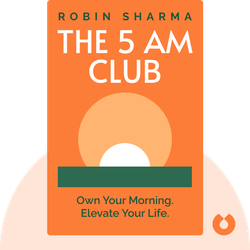Try Blinkist to get the key ideas from 7,000+ bestselling nonfiction titles and podcasts. Listen or read in just 15 minutes.
Start your free trial
Blink 3 of 8 - The 5 AM Club
by Robin Sharma

A Very Short Introduction
Stem Cells by Jonathan Slack is an informative and accessible overview of the science of stem cells, their role in our bodies, and their potential for medical treatments. It provides a clear understanding of this complex topic for readers of all backgrounds.
Before we dive into what exactly stem cells are, let’s start with some basics. Cells – measuring no more than .02 mm in diameter – are the building blocks of any plant or animal. Human bodies have around 200 visually different types of cells. Most of these are known as differentiated cells. This means that they have specific functions and can be clearly identified from their appearance under a microscope. Typical examples include our liver cells, brain cells, and heart muscle cells.
Then there are the undifferentiated cells. These have a more generic appearance. But appearances can be deceptive – some of these cells may also be specialized to perform specific functions. For instance, undifferentiated cells can also be found in embryos and develop into differentiated cells as the embryo grows. Unfortunately, they’re also found in some cancers, where their unrestricted growth capacity can spell bad news.
Some, but not all, undifferentiated cells are what we know as stem cells.
The defining characteristic of stem cells is that they’re able to reproduce themselves and generate offspring that become differentiated cells. They usually exist in an organism for the entirety of its life, inhabiting places like the skin, blood, and lining of the intestines.
To examine these cells, let’s take a closer look at skin. The top layer of your skin, the epidermis, is made up of cells called keratinocytes. During the course of the day, these wear away. So, to maintain your skin, new cells are created by stem cells found in your skin’s basal layer. Some of these cells become new stem cells; others mature and develop into new keratinocytes to replenish the old, injured, or dead cells. The epidermis is what’s called a renewal tissue because it’s continually being renewed. Without these tissue-specific stem cells, that wouldn’t be possible.
The most famous stem cells are now embryonic stem cells, or ES cells. It’s this type of stem cell that’s usually the cause of controversy – and what most people think of when stem cell research is mentioned. But, in reality, ES cells don’t actually exist in nature. They’ve been created by scientists and only exist as tissue cultures kept in laboratories.
ES cells are produced from cells found in early embryos and are capable of producing differentiated cells that can divide without limit – making them pluripotent. They're versatile: they can either divide to create more stem cells or transform into any other type of cell in the body. But not all cells in an embryo are stem cells. Once an embryo has matured, its cells are no longer considered stem cells because they develop into other cell types within just a few days.
OK, that was a lot. To wrap up this first chapter, let’s quickly review the differences between embryonic stem cells and tissue-specific stem cells. Embryonic stem cells are pluripotent, which means they can form any cell type found in the body. Tissue-specific stem cells, on the other hand, aren’t pluripotent – they’re only able to produce cells of the tissue type from which they originate.
In the next few chapters, we’re going to dive deeper into these stem cell types and their possible applications.



Stem Cells (2021) provides an introduction to stem cells – how they’re used by scientists, the therapies that exist today, and what the near future holds. It focuses on the medical and scientific consideration of stem cells and only briefly considers ethical, political, and legal aspects. This “very short introduction” is part of a series of over 650 short introductions covering myriad subjects in every discipline.
Stem Cells (2018) by Jonathan Slack is an informative exploration of the fascinating world of stem cells and their potential for revolutionizing medicine. Here's why you should definitely read it:
It's highly addictive to get core insights on personally relevant topics without repetition or triviality. Added to that the apps ability to suggest kindred interests opens up a foundation of knowledge.
Great app. Good selection of book summaries you can read or listen to while commuting. Instead of scrolling through your social media news feed, this is a much better way to spend your spare time in my opinion.
Life changing. The concept of being able to grasp a book's main point in such a short time truly opens multiple opportunities to grow every area of your life at a faster rate.
Great app. Addicting. Perfect for wait times, morning coffee, evening before bed. Extremely well written, thorough, easy to use.


Try Blinkist to get the key ideas from 7,000+ bestselling nonfiction titles and podcasts. Listen or read in just 15 minutes.
Start your free trial
Blink 3 of 8 - The 5 AM Club
by Robin Sharma
What is the main message of Stem Cells?
The main message of Stem Cells is the incredible potential of these cells to revolutionize medicine and improve human health.
How long does it take to read Stem Cells?
Reading Stem Cells takes a few hours. The Blinkist summary can be read in just 15 minutes.
Is Stem Cells a good book? Is it worth reading?
Stem Cells is a fascinating book well worth reading. It provides a deep understanding of the science and the ethical complexities surrounding stem cell research.
Who is the author of Stem Cells?
The author of Stem Cells is Jonathan Slack.